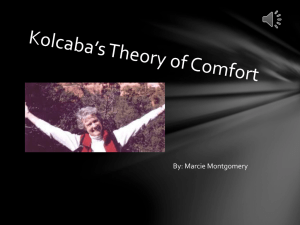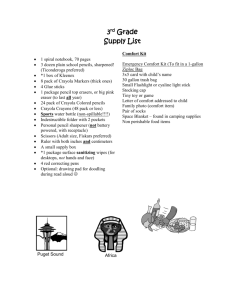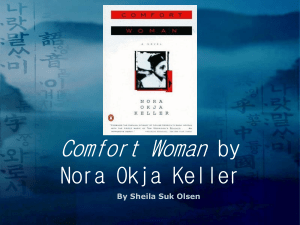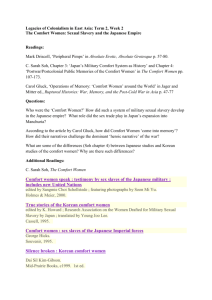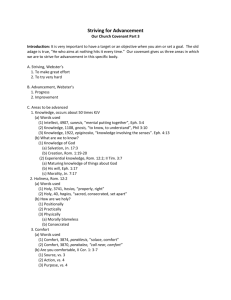Teaching Guide - V-Day
advertisement
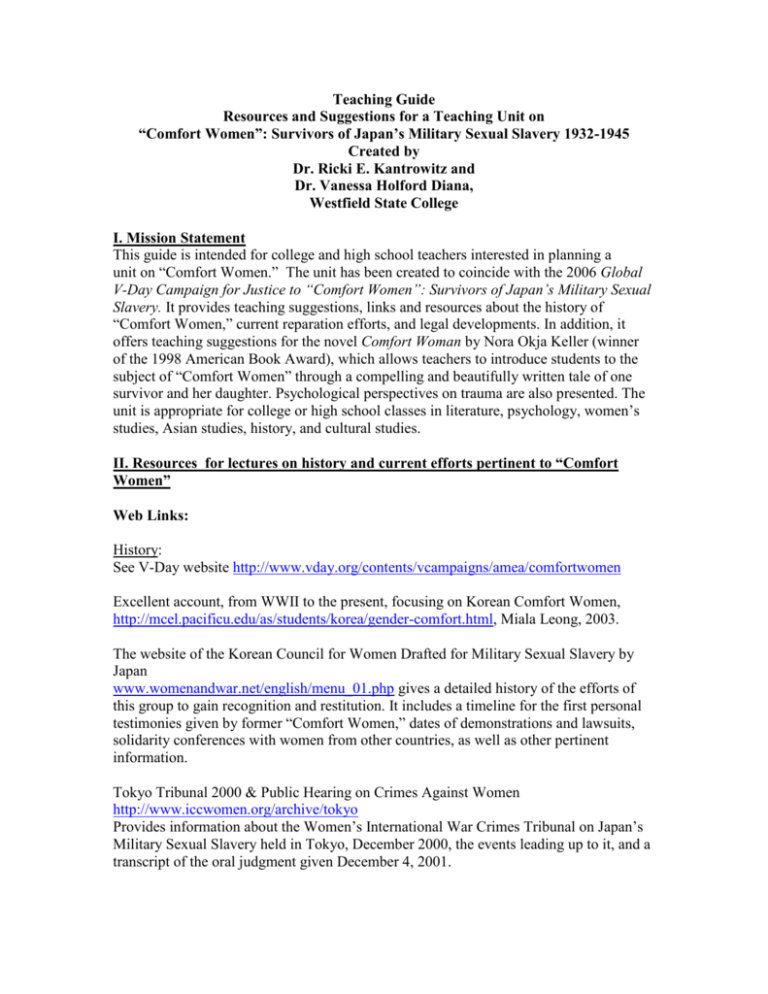
Teaching Guide Resources and Suggestions for a Teaching Unit on “Comfort Women”: Survivors of Japan’s Military Sexual Slavery 1932-1945 Created by Dr. Ricki E. Kantrowitz and Dr. Vanessa Holford Diana, Westfield State College I. Mission Statement This guide is intended for college and high school teachers interested in planning a unit on “Comfort Women.” The unit has been created to coincide with the 2006 Global V-Day Campaign for Justice to “Comfort Women”: Survivors of Japan’s Military Sexual Slavery. It provides teaching suggestions, links and resources about the history of “Comfort Women,” current reparation efforts, and legal developments. In addition, it offers teaching suggestions for the novel Comfort Woman by Nora Okja Keller (winner of the 1998 American Book Award), which allows teachers to introduce students to the subject of “Comfort Women” through a compelling and beautifully written tale of one survivor and her daughter. Psychological perspectives on trauma are also presented. The unit is appropriate for college or high school classes in literature, psychology, women’s studies, Asian studies, history, and cultural studies. II. Resources for lectures on history and current efforts pertinent to “Comfort Women” Web Links: History: See V-Day website http://www.vday.org/contents/vcampaigns/amea/comfortwomen Excellent account, from WWII to the present, focusing on Korean Comfort Women, http://mcel.pacificu.edu/as/students/korea/gender-comfort.html, Miala Leong, 2003. The website of the Korean Council for Women Drafted for Military Sexual Slavery by Japan www.womenandwar.net/english/menu_01.php gives a detailed history of the efforts of this group to gain recognition and restitution. It includes a timeline for the first personal testimonies given by former “Comfort Women,” dates of demonstrations and lawsuits, solidarity conferences with women from other countries, as well as other pertinent information. Tokyo Tribunal 2000 & Public Hearing on Crimes Against Women http://www.iccwomen.org/archive/tokyo Provides information about the Women’s International War Crimes Tribunal on Japan’s Military Sexual Slavery held in Tokyo, December 2000, the events leading up to it, and a transcript of the oral judgment given December 4, 2001. Current efforts: See V-Day website (above) as well as its links to several women’s organizations. Such efforts include the creation of a War and Women’s Human Rights Museum in Korea, Global Signature Campaign with a goal of collecting one million signatures, and a photo exhibit and street march in Taipei, Taiwan. Histories and First-Person Testimonies: The Comfort Women: Colonialism, War, and Sex. Special Issue of Positions: East Asia Cultures Critique 5.1 (Spring 1997). Hicks, George. The Comfort Women: Japan’s Brutal Regime of Enforced Prostitution in the Second World War. NY: Norton, 1994. Kim-Gibson, Dai Sil, ed. Silence Broken: Korean Comfort Women. Parkersburg, Iowa: Mid-Prairie books, 1999. Howard, Keith, ed. The Korean Council for Women Drafted for Military Sexual Slavery by Japan. NY: Cassell, 1995. Schellstede, Sangmie Choi, ed. Comfort Women Speak: Testimony by Sex Slaves of the Japanese Military. NY: Holmes and Meier, 2000. Tanaka, Yuki. Japan's Comfort Women: The Military and Involuntary Prostitution During War and Occupation (Asia's Transformations). NY: Routledge, 2002. Yoshimi, Yoshiaki. Sexual Slavery in the Japanese Military During World War II. Translated by Suzanne O’Brien. New York: Columbia U P, 1995. Films: The following are all powerful, moving films. After showing a film, we suggest that you provide time to discuss students’ reactions. Breaking the History of Silence: The Women’s International War Crimes Tribunal on Japan’s Military Sexual Slavery Produced by: Video Juku, VAWW-Net Japan 2001, 68 minutes For private use $50.00, Institutions (with public viewing license): $200.00 Video-juku@jca.apc.org, 81-3-3401-8944 Shows excerpts of the planning process, proceedings and findings of the Women’s International War Crimes Tribunal held in Tokyo, Japan from December 8-12, 2000. During the proceedings there were testimonies from survivors as well as Japanese veterans who admitted that they had been rapists. Prosecutors and expert witnesses presented their evidence. http://www.jca.apc.org/video-juku/trib-eng.html In addition, Video-Juku offers Hague Final Judgment-The Women’s International War Crimes Tribunal on Japan’s Military Sexual Slavery, 2002, (33 minutes) and 8 short (9 minutes to 40 minutes) videos of testimonies of “Comfort Women” (only 4 in English). Silence Broken: Korean Comfort Women, Dai Sil Kim-Gibson, Director, Writer, Producer 1999, 57 minutes, documentary National Asian American Telecommunications Association Purchase $265, Rental $85 1-888-328-2665 distribution@naatanet.org “The individual testimonies in the film, combined with rare archival footage and dramatized images, create a collective story which embodies the spirit and fortitude of all comfort women.” Cara White, www.kimsoft.com/2000/comfort.htm Until the Violence Stops, Director: Abby Epstein 2004 V-Day productions, 72 minutes Purchase, Docurama, http://www.docurama.com,$26.95 Rental from Netflix, http://www.netflix.com Review of film: http://www.vday.org/contents/vday/press/media/0503211 The middle section of the film includes testimony, photographs and discussion of a group of “Comfort Women” from the Philippines. The Vienna Tribunal, Director: Gerry Rogers 1994, 48 minutes Women Make Movies, Inc. 462 Broadway, Suite 500WS New York, New York 10013 212-925-2052 Purchase, $195.00, Rental $60.00 Order # W99289 Highlights from personal testimonies given at the Global Tribunal on Violations of Women’s Rights. This meeting was held in conjunction with the U.N. World Conference on Human Rights held in Vienna in 1993. The first testimony, about 4 minutes in length, is given by a “Comfort Woman” from Korea. This is a powerful speech. III. Comfort Woman by Nora Okja Keller (Penguin 1997): Teaching Resources Teachers wishing to incorporate literature into a unit on “Comfort Women” might assign Nora Okja Keller’s novel Comfort Woman, winner of the 1998 American Book Award. Brief summary: In her first novel, Keller draws on the distinct voices of Beccah, an obituary writer, and her mother, Akiko, a spirit medium, to illustrate the unconquerable love between mother and daughter. Beccah is lost on the path of life, unsure where her future lies, while her mother is lost in the past, her life caught up in the spirits of the dead, who have haunted her since her escape from the camps where she was a sex slave during the Japanese occupation of Korea in World War II. The story is told from these two women's points of view as each grapples with the terrors, real and imaginary, that dominate their lives. Beccah knows little of her mother's past, and when her mother dies, she is forced to confront the truth. Despite the atrocities recounted and the suffering endured, a fierce love binds these two spirits together, even in death. Erin Cassin, "Library Journal" Copyright 1997 Reed Business Information, Inc. (from amazon.com) Comfort Woman Book Reviews: Davenport, Kiana. “Beyond healing.” Women's Review of Books 14. 10/11 (July 97) 43, 2p. Kakutani, Michiko. “Repairing lives torn by the past” New York Times; 03/25/97, Vol. 146 Issue 50742, pC16, 1bw. Interviews with Nora Okja Keller: Birnbaum, Robert. “Nora Okja Keller: Author of Comfort Woman and Fox Girl talks with Robert Birnbaum” The Narrative Thread (2002) IdentityTheory.com http://www.identitytheory.com/people/birnbaum43.html Hong, Terry. “The Dual Lives of Nora Okja Keller” AsianWeek April 4 - April 10, 2002 http://www.asianweek.com/2002_04_05/arts_keller.html Lee, Young-Oak. “Nora Okja Keller and the Silenced Woman: An Interview” MELUS 28.4 (Winter 2003) 145-165. Critical essays on Comfort Woman: Chu, Patricia P. “To Hide Her True Self': Sentimentality and the Search for an Intersubjective Self in Nora Okja Keller's Comfort Woman” Ty, Eleanor (ed. and introd.); Goellnicht, Donald C. (ed. and introd.). Asian North American Identities: Beyond the Hyphen. Bloomington, IN: Indiana UP(2004): 61-83. Kim, Jodi. “Haunting History: Violence, Trauma, and the Politics of Memory in Nora Okja Keller's Comfort Woman” Hitting Critical Mass: A Journal of Asian American Cultural Criticism 6.1 (Fall 1999):61-78. Koo, Eunsook. “The Colonized Female Body, Nationalism and Colonialism: Nora Okja Keller's Comfort Woman” Journal of English Language and Literature/Yongo Yongmunhak 47.2 (2001):471-86. Lee, Kun Jong. “Princess Pari in Nora Okja Keller's Comfort Woman.” Positions (Duke University Press) 12. 2,1 (July 2004): 431-456. Lee, So-Hee. “A Study of First-Person Narrative in Comfort Woman: From a Perspective of Women's Speaking and Writing.” Feminist Studies in English Literature10.2 (Winter 2002):163-88. Usui, Masami. “Sexual Colonialism in Korea/Japan/America Spheres in Nora Okja Keller's Comfort Woman and Fox Girl” Journal of American Studies 36.1 (Spring 2004): 255-83. IV. Comfort Woman by Nora Okja Keller: Questions for Reading, Reflection, Discussion, and Writing Note that Penguin's Readers Guide for Comfort Woman is included in the back of the novel’s most recent (paperback) edition. The guide offers useful questions for discussion, an interview with Keller, and an autobiographical essay by the author. The supplemental reading questions included here encourage students to chart their comprehension of and responses to the novel in the context of a unit on “Comfort Women.” 1. Trace Keller’s use of imagery of silence and voice throughout the novel and analyze the significance of these images/themes in relation to the history you have learned about “Comfort Women.” 2. Draw connections between Comfort Woman and other novels you’ve read that are alike in some way. Consider similar approaches to narrative structure, treatment of history in fiction, or use of magical realism. For example, Keller’s novel has been compared stylistically to Toni Morrison’s Beloved. For a second novel on the topic of World War II and “Comfort Women,” see Chang-Rae Lee’s A Gesture Life (Riverhead Trade 2000). “A Gesture Life presents . . . two different time frames. In one, delivered via flashback, Hata is a medical officer in Japan's Imperial Army. Posted to a tiny installation in rural Burma, he's ordered to oversee a fresh detachment of Korean ‘comfort women’--i.e., victims of institutionalized gang rape” (James Marcus, from amazon.com) 3. Describe some specific behavior of Akiko’s during the trances when “the spirits claimed her.” How does your understanding of these scenes in the novel change when you consider the description of Post Traumatic Stress Disorder (outlined below, in this guide)? 4. Describe some specific aspect of Akiko’s experience at the Japanese “recreation center” camp. How does your understanding of these scenes in the novel change when you read one or more personal testimonies by survivors of the camps (see references list above)? 5. Describe Akiko’s reaction to her discovery that Beccah is having sex with Max. How has Akiko’s past experience of rape shaped her attitudes toward her daughter’s sexuality? 6. Describe one of the items Beccah finds hidden in her mother’s jewelry box and explain what that item reveals to Beccah about Akiko’s unspoken history. Literary Analysis Paper Assignment: Nora Okja Keller’s Comfort Woman: This paper asks students to focus on one specific stylistic device Keller has used to tell the story of a surviving “Comfort Woman” and her daughter. Storytelling is both a theme and a device of narrative structure in Comfort Woman, where Soon-Hyo’s (Akiko’s) story intertwines with Beccah’s. Keller explains in an interview that Beccah’s “discovery of her mother’s story parallels the world’s discovery of the stories of comfort women. They will not die unknown and unrecognized, lost in history” (155). Keller also comments on her decision to make Soon-Hyo (Akiko) a shaman: “I had a long interest in Korean shamanism. It’s a powerful and fascinating tradition, and I’m drawn to its feminist nature—the fact that the majority of shamans, and the most prominent shamans, are women. It’s a tradition that allows women an unconventional voice in a traditional society” (151). Choose one specific stylistic device (such as alternating narrators, a specific image, or use of flashback, for instance), and explain how that device contributes to Keller’s goal of helping her readers discover the stories of “Comfort Women.” Quotes from Lee, Young-Oak “Nora Okja Keller and the Silenced Woman: An Interview” MELUS 28.4 (Winter 2003) 145-165. V. Related Topics Relevant international documents: a. Beijing Platform for Action http://www.un.org/womenwatch/daw/beijing/platform/index.html In particular, Critical Area of Concern E. Women and Armed Conflict http://www.un.org/womenwatch/daw/beijing/platform/armed.htm The following is an excerpt from this section: The Geneva Convention relative to the Protection of Civilian Persons in Time of War, of 1949, and the Additional Protocols of 1977 [24] provide that women shall especially be protected against any attack on their honour, in particular against humiliating and degrading treatment, rape, enforced prostitution or any form of indecent assault. The Vienna Declaration and Programme of Action, adopted by the World Conference on Human Rights, states that "violations of the human rights of women in situations of armed conflict are violations of the fundamental principles of international human rights and humanitarian law". b. Convention on the Elimination of All forms of Discrimination Against Women (CEDAW) http://www.un.org/womenwatch/daw/cedaw/ An International Bill of Rights for Women. c. Rome Statute of the International Criminal Court 1998 http://www.un.org/law/icc/ The Rome Statute has “incorporated a gender perspective to ensure that women who are victims of the gravest crimes under international law have access to justice and that women play a role in the Court.” (from Amnesty International, Broken Bodies, Shattered Minds, see below) d. UN Security Council Resolution 1325 on Women Peace and Security http://www.un.org/events/res_1325e.pdf Annotated version from UNIFEM (United Nations Development Fund for Women) http://www.womenwarpeace.org/toolbox/annot1325.htm Focuses on the inclusion of women in peace-building activities and includes a section on the need to protect women and girls in war and conflict. Books, Reports, and Other Resources: a. Amnesty International, Broken Bodies, Shattered Minds: Torture and Ill-Treatment of Women, 2001, http://web.amnesty.org/library/Index/engACT400012001, see “Torture of Women in Armed Conflict.” Torture is defined as including rape and other sexual abuse of women and girls. b. Amnesty International, Casualties of War: Women’s Bodies, Women’s Lives, Stop Crimes Against Women in Armed Conflict, 2004 http://web.amnesty.org/library/engindex (search for title) c. Amnesty International’s campaign, Stop Violence Against Women. The campaign online is: www.anmnesty.org/actforwomen d. Center for Women’s Global Leadership http://www.cwgl.rutgers.edu/globalcenter/takeaction.html Includes suggestions about getting involved in women’s human’s rights issues. e. Human Rights Watch Women’s Human Rights http://www.hrw.org/women/ f. McDougall, G. Contemporary Forms of Slavery: Systematic Rape, Sexual Slavery And Slavery-Like Practices During Armed Conflict, June 22, 1998 Commission on Human Rights, 15th Session, UN Document E/CN.4/Sub.2/1998/13 (Put the document number into your search engine and you will find this document online.) g. Not a Minute More: Ending Violence Against Women Combating Gender Based Violence: Achievements And Ways Forward UNIFEM, 2003 “Highlights many of the achievements in combating violence against women, and suggests recommendations as to what must be done to build on the achievements and address the challenges.” http://www.eldis.org/static/DOC14057.htm also www.unifem.org/resources (search title) h. Picturing a Life Free of Violence: Media and Communications Strategies to End Violence Against Women www.unifem.org/resources (see link) i. Public Hearings on Crimes Against Women in Recent Wars and Conflicts held December 11, 2000 in conjunction with the Tokyo Tribunal, see Women’s Caucus for Gender Justice’s website: www.iccwomen.org/archive/tokyo/ Sixteen women “gave testimonies about recent violations they have suffered in different parts of the world which have gone unpunished. The purpose of the Public Hearing was to show that the impunity enjoyed by the perpetrators of the crimes against the former comfort women fosters impunity for future perpetrators.” Provides information about the public hearing as well as a synopsis of testimonies. j. Rehn, E & Sirleaf, E. J., Women, War and Peace: The Independent Experts Assessment on the Impact of Armed Conflict on Women and Women’s Role in Peace-building. UNIFEM, www.unifem.org (search for Progress of the World’s Women 2002, Vol. 1) Examination of violence against women prior to, during and post-conflict situations and the implementation of UN Security Council Resolution 1325, Women Peace and Security. Fourteen conflict areas are discussed, including East Timor, Balkans, Somalia and Sierra Leone. Many testimonies from women are provided. k. United Nations High Commissioner for Human Rights, http://www.ohchr.org see Special Rapporteur on violence against women l. United Nations High Commissioner for Refugees www.unhcr.ch/ m. Widowhood And Armed Conflict: Challenges Faced And Strategies Forward Workshop on Widowhood organized by the International Committee of the Red Cross and the Australian Red Cross, at the 27th International Conference of the Red Cross and Red Crescent, November 1999. http://www.icrc.org/Web/Eng/siteeng0.nsf/html/57JQHA?OpenDocument n. Widows’ Rights International http://www.widowsrights.org/ o. Women and Armed Conflict; International Justice http://www.hrw.org/women/conflict.html In-depth reports about women and armed conflict in such areas as Sudan, Iraq, Sierra Leone and Kosovo. p. Women’s Initiatives for Gender Justice: Strengthening Advocacy in Women’s Human Rights and International Justice http://www.iccwomen.org q. WomenWatch: The UN Internet Gateway on the Advancement and Empowerment of Women http://www.un.org/womenwatch/ Information and Resources on Gender Equality and Empowerment of Women. r. . www.WomenWarPeace.org, a Web portal, with information about the impact of war on women and girls. VI. Psychological Issues Related to Trauma Mental Health Consequences: Health and Mental Health Consequences of Violence Against Women Ending Violence Against Women, Population Reports, Series L, Number 11, Volume XXVII, Number 4, December, 1999, Issues in World Health http://www.infoforhealth.org/pr/l11edsum.shtml See Section 5, Threats to Health and Development, including Violence Erodes Women’s Mental Health http://www.infoforhealth.org/pr/l11/l11chap5_3.shtml#top World Health Organization, Fact Sheet No 239, Revised June 2000, Violence Against Women http://www.who.int/mediacentre/factsheets/fs239/en/index.html Post Traumatic Stress Disorder (PTSD): Students may find it helpful to think about Akiko’s behaviors and symptoms in Comfort Woman as a manifestation of Posttraumatic Stress Disorder (PTSD). The following summary of the diagnostic criteria for PTSD is adapted from the Diagnostic and Statistical Manual of Mental Disorders, Fourth Edition, (DSM-IV), American Psychiatric Association, 1994. Please note that not all symptoms are listed. A. Exposure to a traumatic event in which the person faced an event that involved actual or threatened death or serious injury to self or others and the response involved intense fear, helplessness or horror. B. Re-experiencing the traumatic event in one or more of these ways: recurring and distressing images, thoughts or perceptions; distressing dreams and nightmares; acting or feeling as if the event were recurring, through misperceptions, hallucinations and dissociative flashbacks; emotional distress or physiological reaction to stimuli, internal or external that represent the traumatic event. C. Avoidance of stimuli associated with trauma and numbing of emotional responsiveness including three of the following: avoidance of thoughts, feelings, conversations, activities, places, and people associated with the trauma; feeling detached from others; having a restricted range of emotion; and not expecting to live a normal life span. D. Chronic state of hyperarousal including two or more: easily startled, insomnia, trouble concentrating, irritability or anger outbursts, and hypervigilance. E. Duration of symptoms for more than one month F. Disturbance causes clinically significant distress and/or impairment in social, occupational and/or other important areas of functioning. Note: Can be delayed onset of symptoms at least 6 months after the incident and can last for years. Other useful links on PTSD: American Psychiatric Association’s brochure: Let’s Talk Facts About Posttraumatic Stress Disorder http://healthyminds.org/multimedia/ptsd.pdf How trauma can affect Relationships http://www.istss.org/terrorism/Trauma_and_Relationships.htm Controversies about the Use of PTSD: The use of a psychiatric diagnosis, such as PTSD, as a label for behaviors and symptoms in response to trauma is a controversial topic. Psychology students might be asked to research this controversy. A starting point could be the following articles: http://bmj.bmjjournals.com/cgi/content/full/323/7312/561 Usefulness and validity of post-traumatic stress disorder as a psychiatric category Mezey, G. & Robbins, I. BMJ 2001; 323:561-563 (8 September). http://www.studentbmj.com/issues/01/03/education/61.php The invention of post-traumatic stress disorder and the social usefulness of a psychiatric category Summerfield, D. StudentBMJ 2001;09:43-84 March. VII. RESEARCH and ACTIVISM PROJECTS 1. Have students read about activities that have been undertaken on behalf of former “Comfort Women” in the following countries: Korea, China, Taiwan, North Korea, the Philippines, Indonesia, Malaysia, the Netherlands, and E. Timor. When did “Comfort Women” in these countries first speak out? How many are still alive? What types of reparations are they requesting? Which organizations are working on behalf of these women? 2. Have students select an area where there has been sexual violence against women during a period of armed conflict, such as the former Yugoslavia and Rwanda. Describe how these crimes were brought to the attention of the world through the International Criminal Tribunals for the former Yugoslavia and for Rwanda. 3. Identify current examples of sexual violence and systematic rape during armed conflict. Assign students to look at these issues in specific countries, including Sudan, Congo and Iraq. Use resources such as: Human Rights Watch Women’s Human Rights (see e above); Rehn, E & Sirleaf, E. J., Women, War and Peace: The Independent Experts Assessment on the Impact of Armed Conflict on Women and Women’s Role in Peacebuilding (Progress of the World's Women 2002, Vol. 1)(see j above) where 14 areas of conflict are discussed; and Public Hearings on Crimes Against Women in Recent Wars and Conflicts (see i above) where 16 personal testimonies are given. 4. Students should select a topic that may be an additional concern for women who have been affected by sexual violence during armed conflict. See suggestions below. Create assignment from the following: Describe how the issue affects these women. Use the Internet or articles in the library to find NGOs or agencies, including UN agencies, working on behalf of women. What are a few of the major obstacles to change? What kinds of programs have these organizations developed? Be specific about a few programs in particular countries. Are you hopeful about change? Why or why not? Possible Topics: a. The Status of Widows b. Women and Torture c. Refuge Women/Displacement d. HIV/AIDS in Survivors of Sexual Violence e. Mental Health Impact of Sexual Violence f. Health Impact of Sexual Violence 5. Research Project on Contemporary Global Women’s Activism: This assignment can be adapted with a focus on current efforts by and on behalf of survivors of forced sexual slavery by the Japanese military. The V-Day Spotlight Campaign site includes links to a number of activism organizations students might research further. Students can write individual research papers or work in groups. Whether alone or in groups, students can move beyond compiling their findings in a written report by presenting their findings to the class or to a larger audience at the school (for example, as part of a Women’s History Month program). Assignment Guidelines: Profile an international women’s activist organization with a feminist mission. The purpose of this paper is to educate readers (your peers) about the group’s mission, the need for the group, specific actions/accomplishments of the group, and how your peers might get involved. Your profile must begin by offering background information on the issue or issues that the organization addresses. You will need to draw on a broad range of research sources in order to demonstrate that a problem exists and therefore the activist organization is necessary. Then explain how the organization addresses the issue. What is the group’s mission? Who are the members? What specific forms of activism does it utilize? What accomplishments has the organization achieved? Where is funding acquired? What actions have they taken recently? What struggles have they faced? What countries are involved in the group’s efforts? Are there comparable organizations in other cities/states/countries? Your paper or presentation should conclude with a local connection; in other words, how can students at your school get involved directly with this organization or participate in activities locally that work toward the same mission? This Guide was created for V-Day by: Dr. Ricki E. Kantrowitz is Professor of Psychology at Westfield State College where she teaches courses in counseling, women and mental health, and crosscultural psychology. She is also a psychotherapist in private practice. She is an NGO representative of the World Federation for Mental Health at the United Nations, serving as co-convenor of the Gender Perspectives Working Group of the NGO Committee on Mental Health. She has received three Fulbright-Hays Summer Seminars Abroad grants: Korea (1989), Hungary (1993), and Morocco (2004). And Dr. Vanessa Holford Diana is Assistant Professor of English and Coordinator of the Women's Studies Program at Westfield State College in Westfield, MA, where she teaches courses in multicultural American literature, writing, and women's studies. Her research focuses on fiction by nineteenth- and twentieth-century women writers of color in the United States.

